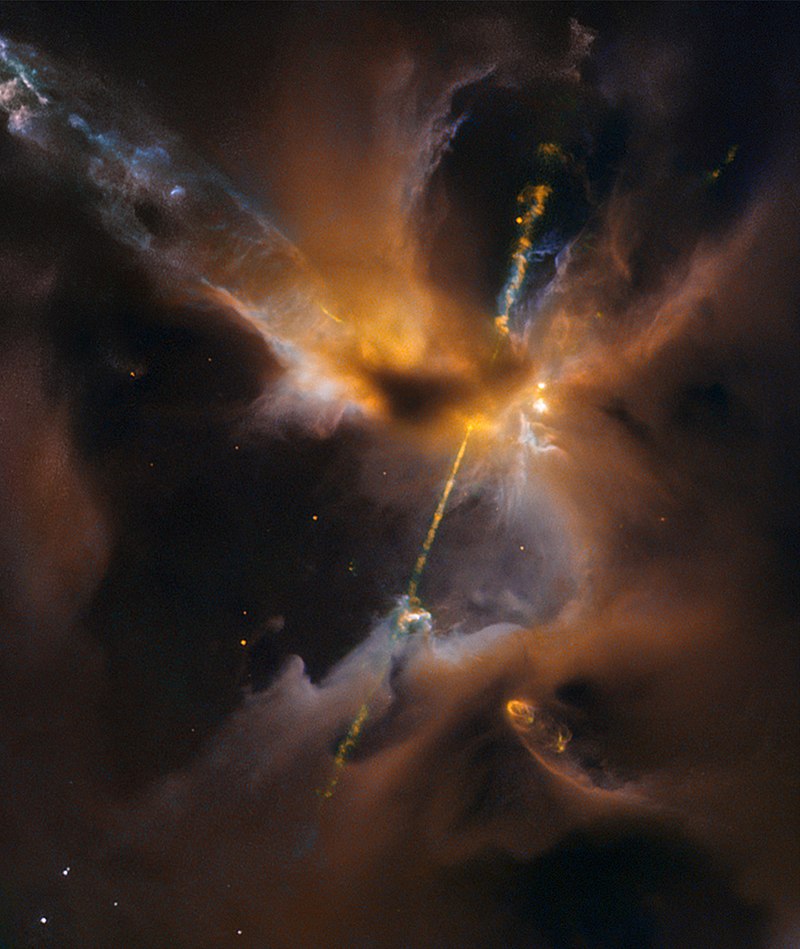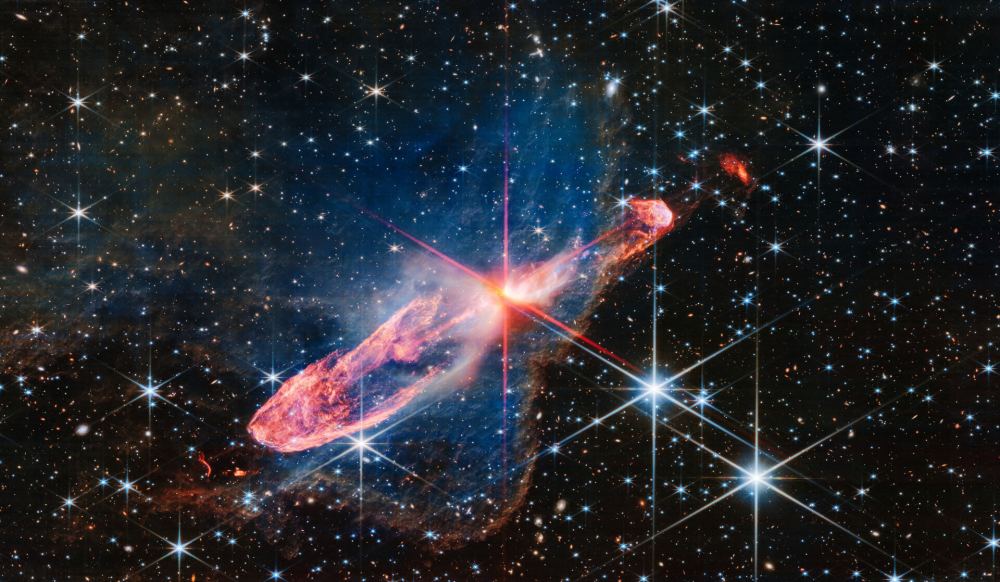In 1985, the physicist Heinz Pagels wrote that star birth was a “veiled and secret event.” That’s because the stellar crêches hide the action. But, ever since the advent of infrared astronomy, astronomers have been able to lift that veil. In particular, the Hubble Space Telescope has studied these systems and now, the Webb Telescope (JWST) gives regular detailed views of stellar nurseries.
Recently, JWST took a look at the Herbig-Haro 46/47 system. It’s a pair of still-forming binary stars hidden inside a nebula that lies about 1,470 light-years away from us. Normally in visible light, this scene appears as a black cloud with a bright streak of light beaming away from it. But, in the JWST view, we can see a lot more detail.

What’s Happening to These Binary Stars
In the JWST image, the newborn binary stars are in the orange-white blob in the center of the nebula. JWST couldn’t see past that smaller cloud of gas and dust because it was so thick. Indeed, it’s still “feeding” the young stars. They gain mass until the birth cloud gets used up.

Each of the binary stars sends out jets of superheated material across thousands of light-years. They carry material that formed two orange-colored lobes of material on either side of the star-birth crêche. As these baby binary stars gobble up the gas in the birth cloud, they also eject gas and dust out to space. That’s what built up the lobes of material. Their presence influences the shapes of the jets. As ejected material rams into the nebula, the jets interact with molecules within the nebula, causing them both to light up.
Jets are a major part of the star-birth process. They regulate how much mass the young stars can gather up. As the jets move material out, that ejected “stuff” collides with the rest of the nebula. All these details make this JWST image one of the most detailed looks to date at the action inside a star-birth nursery.
Herbig-Haro Objects
The HH 46/47 system is one of many such star-birth sites around the galaxy. They all have the same types of features: glowing clouds of gas and dust associated with newborn stars that shoot jets of material across space. Astronomers have known about them for more than 100 years. However, astronomers didn’t associate them with star birth until the 1940s. That’s when George Herbig and Guillermo Haro studied and wrote about them as possible sites of star formation.

HH objects usually are associated with so-called H II regions and often lie near dark clouds called Bok globules. There are more than a thousand known (so far) and they offer a way to study star formation from its early stages. Typically in star formation, a cloud of material collapses, and eventually stellar cores, called protostars, form in the cloud. The protostars continue to accrete material—and shoot it out along the axis of rotation in bipolar jets. The jets collide with material around the star and that triggers the bright emissions that characterize HH objects.
What Will Happen to These Newborn Binary Stars?
JWST’s image captures a single moment in the long evolutionary process of creating new stars. Eventually, HH 46/47 will have gathered enough material and the jets will eventually die away. The birth crêche will be largely (or maybe even completely) eaten away and replaced by the hot young stars. Interestingly, most of the stars associated with HH objects will be binary stars or in multiple-star systems. That raises questions about the mechanisms that give rise to the jets flowing away from the stars. Many stars in the galaxy are born in these multiple systems, so the existence and evolution of HH systems give interesting insights into the whole star birth process.
Studying these systems in infrared light is a whole new ballgame in understanding the origin and evolution of stars. Hubble Space Telescope and the JWST are showing incredibly detailed views of the jets and clouds surrounding the newly forming stars in these systems. From the ground, radio and submillimeter instruments such as ALMA study them, too. Thanks to these observatories, the veiled and secret process, except for the most densely packed clouds, is no longer so hidden or secret.
For More Information
Webb Snaps Detailed Infrared Image of Actively Forming Stars (image and caption)
Webb Snaps Highly Detailed Infrared Image of Actively Forming Stars (longer story)

